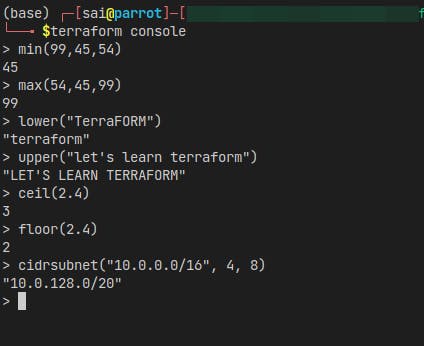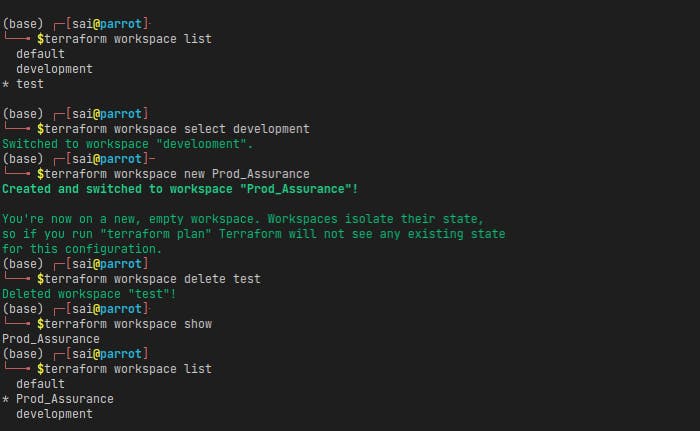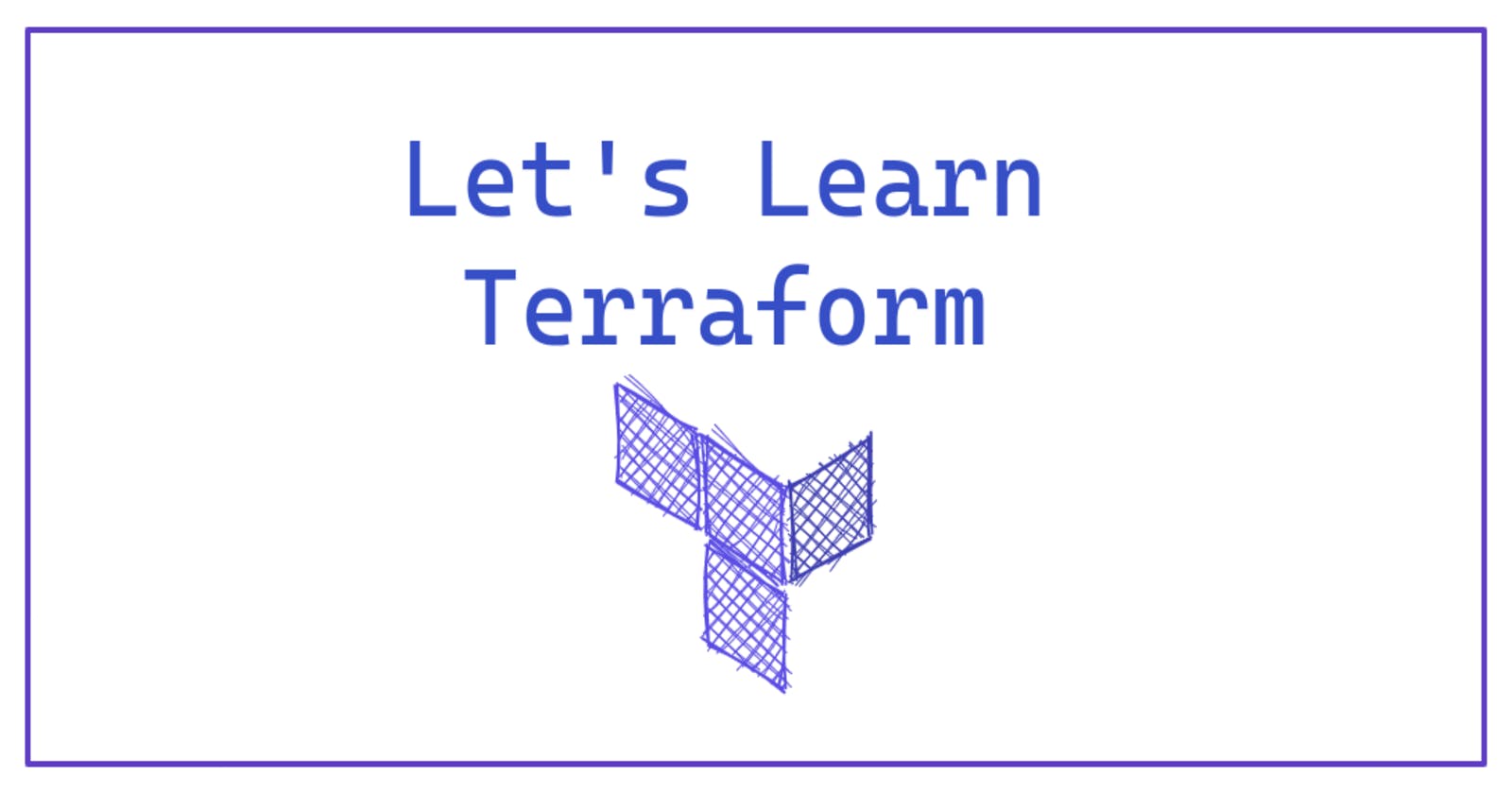Let's Learn: Terraform
A deep dive into Terraform. It's components, workflow, expressions, state data, functions, workspaces and more
Table of contents
- What is Terraform?
- Core Components
- Terraform Code Components
- Object Types
- Terraform Syntax
- Workflow
- Terrafrom variable
- Terraform Data Types
- Terrafrom Locals
- Terraform Output
- Terraform State Data
- Terraform Providers
- Terraform Block Syntax
- Terraform Looping Constructs
- Terraform Inbuilt Functions
- Terraform FOR Expression
- Terraform Workspaces
- Additional Resources
What is Terraform?
- Terraform is an Infrastructure Automation tool.
- It is Open Source and Vendor Agnostic.
- It is a Single binary compiled from Go.
- It follows Declarative syntax.
- It uses HashiCorp Configuration Language(HCL) or JSON.
- Deployment is push based.
Core Components
- Executable
- Can be downloaded from official Terraform webpage.
- Configuration files
- Provider plugins
- State data
Terraform Code Components
- It can be divided into 3 parts:
- Inputs - Terraform gets input by leveraging variable(s).
- Outputs - The data in the output block is printed to screen.
- Logic - Your IaC.
Object Types
- Providers
- Resources
- Data sources
Terraform Syntax
HashiCorp uses Block syntax
block_type "label" "name_of_label" { key = "value" nested_block{ key = "value" } }Workflow
terraform initLooks for configuration files in current working directory and examines them. If they need any provider plugins, it will search in public Terraform registry unless any specified location provided.
Terraform needs to store data of configuration somewhere as part of init process. A state data file will be created in current directory unless any specified backed it created or pointed.
When init completes, infrastructure is ready to be deployed.
terraform plan- This step is optional.
- It will look current configuration i.e. contents of state data and determine the difference. Then it draws a plan for Target environment to match the desired configuration.
terraform apply- It will build our desired configuration in Target environment.
terraform destroy- It will bring down the infrastructure of desired configuration in Target environment.
Terrafrom variable
Variable declaration
variable "name_of_variable" {}Variable definition
variable "name_of_variable" { type = value description = "value" default = "value" sensitive = true or false }- Example
variable "device_name" { type = string description = "Provides the Device name" default = "computer" sensitive = true }
- Example
type - Data type
- Description - Context for the user. It will be displayed when the user encountered an error.
- default - This value will be considered if no value has been provided.
sensitive - If it is 'true', data will not be printed in logs or terminal. If 'false', vice versa. Default sticks to 'false'.
Referencing a variable
var.<name_of_variable>- Example
var.device_name
- Example
Hierarchy
- For variable(s) data or value, Terraform designed a precedence chart.
Precedence
Environment variable(s) > .tfvars (or) .tfvars.json > .auto.tfvars (or) .auto.tfvars.json > -var-file flag > - var flag > CLI
Terraform Data Types
Primitive
- string
- number
- integer
- decimal
- boolean
- true
- false
Collection
list
- Enclosed with [ ]
- Example
[1,2,3] ["Mobile", "Computer", "Laptop"] - Variable reference
- Example
variable "list_of_device_types"{ type = list(string) description = "Provides list of device types" default = ["Mobile","Computer","Laptop"] } - Syntax
var.<name_of_variable>[<element_number>]- Example
- var.list_of_device_types[0]
- For accessing first element in list. Likewise for other elements accessing.
- Example
- Example
set
- Same syntax as list and do not hold duplicates.
map
- Enclosed with { }
- Example
{ India = "Delhi" USA = "Washigton" Canada = "Ottawa" } Variable reference
- Example
variable "capitals"{ type = map(string) description = "Provides captials for countries." default = { India = "Delhi" USA = "Washigton" Canada = "Ottawa" } } Syntax
var.<name_of_variable>.<name_of_the_key> or var.<name_of_the_variable>["name_of_the_key"]- Example
- var.capitals.India or var.capitals["India"]
- For accessing first element in map. Likewise for other elements accessing.
- Example
- Note: Should hold same type of data.
Structural
- type
- object
Terrafrom Locals
Values provides in locals are computed inside the configuration and cannot be passed as parameter during runtime.
Syntax
locals{ key : "value" }- Example
locals{ name_of_the_company = "ThunderWonder" } - Referencing locals
- syntax
local.<name_of_the_variable> - Example
local.name_of_the_company
- syntax
Terraform Output
- Output values are extracting information from Terraform.
- Output is printed to terminal screen at the end of configuration execution.
It also exposes values when a configuration is placed inside a module.
Syntax
output "name_of_the_variable"{ value = output_to_be_exposed description = string sensitive = true | false }- Example
output "selected_device"{ value = var.list_of_device_types[0] description = "Prints selected device(s). }
Tip: If you want to validate your Terraform code. Type terraform validate.
- First run
terraform init. terraform validatewill check for your syntax and logic.- It will not guarantee for successful deployment.
Terraform State Data
- It stored in JSON format
- Important: It should not be modified. To work with State Data, we can use State commands.
- It contains Resource Mapping and metadata.
It can be stored in:
- Local (Default, by name terraform.tfstate)
- Remote (Basically Cloud Providers)
- Ex: AWS, Azure, Terraform Cloud, etc.
State Commands
terraform state list- To list all state resources.
terraform state show <ADDRESS>- To show a specific resource.
- Example :
terraform state show module web_app_s3.aws_s3_bucket.web_bucket
terraform state mv SOURCE DESTINATION- To move an item in state file.
terraform state rm <ADDRESS>- To remove an item in state file.
- Example:
terraform state rm module web_app_s3.aws_s3_bucket.web_bucket
terraform state pull- Output current state to stdout.
terraform state push- Update remote state from local.
Terraform Providers
- Update remote state from local.
- It contains Public & Private registries.
- Registries types are:
- Official
- Maintained by HashiCorp.
- Verified
- Maintained by Third Party and verified by HashiCorp.
- Community
- Maintained by Individuals in Community and not verified.
- Official
- Providers are Open Source and written in Go Lang.
- It has Resources and Data Sources.
- Providers are versioned.
Terraform Block Syntax
- It is used for configuring General Settings of Terraform Configuration like,
- Version
- Backend Settings for State Data
- Required Provider Plugins
- Provider metadata
- Experimental features
- Syntax
terraform{ requried_providers { provider_name = { source = "provider's_address" version = "version_expression" } } }- Example
terraform{ requried_providers { aws = { source = "hashicorp/aws" version = "=3.0" } } }
- Example
Terraform Looping Constructs
count
- Takes integer and used as iterator.
indexis used to keep track of count.- Example
resource "aws_instance" "web_app_server"{ count = 3 tags = { Name = "web-app-Instance-${count.index} } } - Referencing
- Referring single instance
<resource_type><name_of_the_variable>[element].<attribute> - Referring all the instances
<resource_type><name_of_the_variable>[*].<attribute>
- Referring single instance
for_each
- used to for iterating Map or set/list.
- Example
resource "aws_s3_bucket_object" "website_content"{ for_each = { app_logo = "app-logo.png" main_page = "index.html" } key = each.value source = "${each.value}" } - Referencing
<resource_type><name_of_the_variable>[key].<attribute>
- Dynamic block
- used to for iterating Map or set/list.
Terraform Inbuilt Functions
- Numeric Functions
- String Functions
- Collection Functions
- Encoding Functions
- Filesystem Functions
- Date and Time Functions
- Hash & Crypto Functions
- IP Network Functions
- Type Conversion Functions
- You can play around with in-built functions. Type
terraform consoleand test it out. Example

- Check out Terraform Functions documentation for respective function methods, and it's usage.
- Note: Terraform does not support for User-defined functions.
Terraform FOR Expression
- Input type:
- List, Set, Tuple, Map or, Object.
- Result type:
- Tuple or Object
Filtering is possible by leveraging if statement.
Examples
Tuple
- Syntax
[for item in items : tuple_element] Example
locals{ devices = ["Mobile", "Laptop", "Tablet"] } [for device in local.devices : "Awesome-${device}"]Result

- Syntax
Object
- Syntax
{for key, value in map : obj_key => obj_value} Example
locals{ type_of_device{ Mobile = "compact" Laptop = "productive" } } {for key, value in local.type_of_device : key => upper(value)}Result

- Syntax
Terraform Workspaces
- Terraform creates a initial workspace for us called default.
- It cannot be deleted.
- We can create workspace(s) per our requirement and management.
- Management like
- State management
- Variable values
- Credential management, etc.
- Management like
workspace commands
terraform workspace list- To show all existing workspaces.terraform workspace select <workspace_name>- To switch to desired workspace.terraform workspace new <workspace_name>- To create & switch to new workspace.terraform workspace delete <workspace_name>- To delete existing workspace.terraform workspace show- To print current working workspace.Example

Additional Resources
- Wanna try or start your Terraform practice ?
- Start your Terraform practice today. For head start or reference check out my Terraform practice at GitHub. Feel free to fork and enhance your Terraform practice.
- Interested to learn more about variables like validations, limitations? Do check How to Use Terraform Variables.

